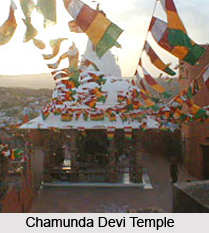 The Chamunda Devi Temple located at a distance of 15 km from Dharamsala in the state of Himachal Pradesh is dedicated to Goddess Durga or Chamunda. The serenity of the place and the calmness of nature provide an excellent venue for meditation and spiritual attainments. People of twenty-two villages used the location of the temple as a cremation ground. It was supposed to be a place of solace.
The Chamunda Devi Temple located at a distance of 15 km from Dharamsala in the state of Himachal Pradesh is dedicated to Goddess Durga or Chamunda. The serenity of the place and the calmness of nature provide an excellent venue for meditation and spiritual attainments. People of twenty-two villages used the location of the temple as a cremation ground. It was supposed to be a place of solace.
According to the legend, the two wicked demons Chanda and Munda of Shumbh Nishumbh, the notorious demon king, tried to harass goddess Ambika. This turned into a battle between the gods and demons. Chandika then destroyed those two demons and presented their heads in front of Ambika. At this dreadful act of Chamunda, Ambika became pleased and named the city after Chamunda. Since then the Chamunda Devi Temple is worshipped with faith and enthusiasm.
This temple was built 700 years before and comprises of a big complex with a `kund` or pond in it. As per the rituals, the devotees who come to worship take a holy dip into the `kund`. The visitors are not permitted to view the main deity of the temple. It is kept covered because of its sacred importance. At the back of the temple, there is a cave-like scoop. It represents the stone lingam, which is an embodiment of Lord Shiva. Other than these, there are many brightly painted images of various gods and goddesses located in the vicinity of the Chamunda Devi Temple.





















